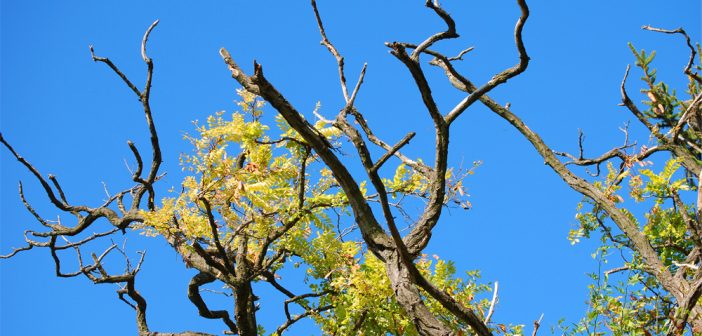Healthy trees in good soil can provide a wind break, protection from the glaring sun, a buffer for storm winds, and a beautiful and comfortable spot to relax outdoors. On the other hand, with your average oak tree weighing many tons, trees can be a formidable force against your house when they are dead or dying. Oak is exceptionally heavy, but trees of all types can crush through brick walls, smash cars, flatten sheds, crash through roofs and a whole lot more. Here is how to tell if trees on your property are dying and becoming a fall risk.

Tree Girdling
This can be an intentional or unintentional act. Tree girdling is a method used to kill branches or trees. Only a narrow area between the outer bark and the inner wood of the tree is alive and carrying nutrients. If you cut a strip of bark away all the way around the trunk or a branch, all of the area above the cut will die. Many homeowners unintentionally girdle trees in their yards using weed trimmers. Over time they may strip an area of bark all the way around the trunk that causes stress and eventual death of the tree. If you suspect girdling, your tree needs to be professionally assessed and monitored.
Leaf Changes
If you have a deciduous tree that has leaves turning yellow or brown during the active growing season of summer, the tree is stressed and may be dying. If it is just confined to one branch, then the problem may be limited to just that branch. For evergreens, the needles will change color. You may see areas that begin to turn brown or red. This is an indicator that the tree is stressed or dying. A large section of brown needles indicates the tree is dying. Stressed trees may have needles that are yellowing in sections.
Insect Infestation
If you see bore holes from beetles and signs of carpenter ants, the tree may be dying. Ants living in a tree are probably not harming the tree. However, ants will build a colony inside of trees where there are cavities to build a nest. The wood of the interior of your tree may be rotted away, and there is no way to tell how much wood inside the tree remains without taking core samples. The strength of a tree may be severely lessened if its heartwood and sapwood are compromised even if it looks healthy on the outside. Squirrel and bird nests may be signs of localized damage or worse. This is a situation that requires a professional to assess.
Missing Bark
Except for tree species that shed bark, such as sycamore, silver maple and birch trees, missing bark is usually a sign that the tree, or at least the affected branch, is dying. Some trees can lose bark in large pieces and still be perfectly healthy. A sign that the tree is just shedding bark and not losing it due to problems is the formation of new bark underneath. Some tree species are known to have what is called “exfoliating bark.” Some may exfoliate from the time they are just saplings, but others may not exfoliate until they are well established. Paper birch and Armur chokecherry are a couple examples of tree species that exfoliate their bark. It can become prominent in the winter, making you think a tree of this type has died.
Fungal Growth
Mushrooms and other fungi grow where organic material is rotting. It may be a little natural mulch of leaf debris around the base of the tree fostering the growth of a few mushrooms, or it may be root damage that indicates that the root system is compromised and rotting. Fungi growing on branches or the trunk indicates that at least part of the tree is dead and rotting. If your standing tree looks like the example of fallen branches in the area that are covered in fungi, the tree is probably dead or nearly dead. Plus, there are many fungal diseases that can kill trees that are not going to provide you the evidence of large clusters of fungal growth that can easily be spotted.
Missing Leaves
Dying trees may have only a few branches that are actively growing any leaves. If you have several bare branches on a deciduous tree during the growing season or if you see several bare branches on an evergreen, at least part of the tree is dying. If part of a tree is dying or dead, it will not be long before the rest of the tree follows. It is better to have the tree assessed and removed before the rest of it dies.
Check the Tree for Signs of Life
If you have a tree that is not budding when you expect it to in the spring, you can check its bark to determine whether it is dead or not. Start with a small branch where the buds will form and scratch away a tiny section of the outer layer of the bark. If it is green underneath, the tree is still alive. If the scratch test does not reveal any green, check a few more areas. If you cannot find any green doing scratch tests, the tree is very likely dead. Remember, only a thin layer under the bark of the tree is alive and carrying nutrients for the tree to grow and thrive. The rest is non-living wood that makes up the bulk of the wood structure of the tree.
Specially trained arborists can identify tree diseases, tree stress and trees that are dead. If you have a favorite tree in your yard that you are concerned is dead or dying, it is best to ask a professional for advice before cutting it down. However, there is also the need to err on the side of caution when it comes to protecting your home, your family and your neighbors from the danger of a large tree falling, which can cause injury or death to someone.








